Perhaps instead of “where’s the beef?” the big question should be “what are the different cuts of beef?” Though most people know at least one or two of the different cuts of beef, there are actually quite a few different primary cuts from which millions of recipes can be made.
The texture and flavor of the cut are determined by the part of the animal from which it is cut, and this can make the difference between whether it’s suitable for grilling, braising, using as taco filling, or serving with sauce espagnole.
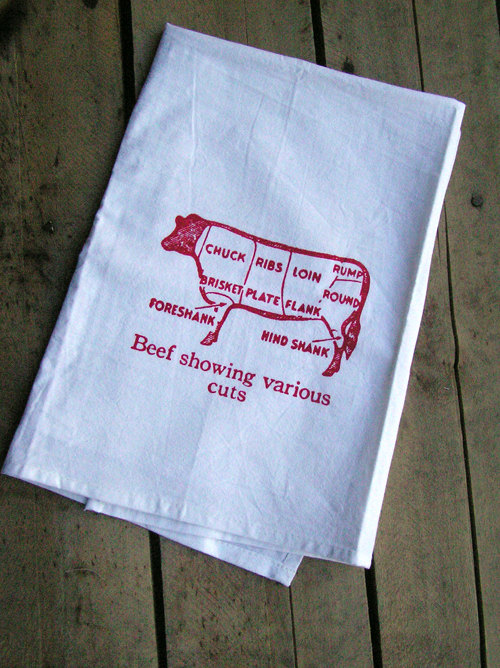
Photo via Sunday Drive Designs
Here’s a primer on different cuts of beef to get you acquainted.

Photo licensed via Creative Commons by Flickr member roboppy
Brisket
What it is is:
A cut of meat from the breast and lower chest of beef or veal. While the borders of this cut can vary depending on who you ask or what part of the world you’re in, brisket generally includes some of the outer and inner pectoral muscles. Since this is a very “worked” muscle, brisket is a somewhat tougher cut of meat.
How to cook it:
Many beloved methods include slow cooking of some sort owing to its somewhat tough texture. Braising is very popular, allowing the meat to first sear and then simmer to tender, flavorful perfection. Smoking is also very popular, first marinating and then slow cooking the meat over wood or charcoal slowly until it is practically fork tender. Kansas City barbecue is a particularly famous version of smoking in which the meat is slow smoked and then covered in a thick barbecue sauce with tomato and molasses, and it works splendidly with brisket.
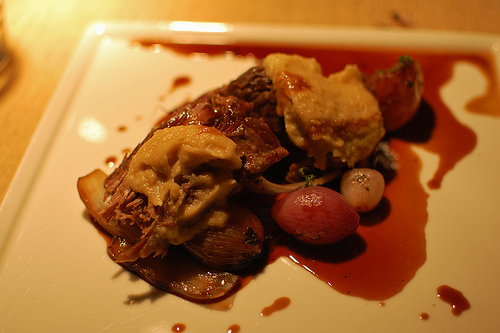
Photo licensed via Creative Commons by Flickr member Tamarind and Thyme
Chuck
What it is:
A chuck steak is a rectangular cut of meat that sits above the rib and includes part of the shoulder. Since this is an area with a lot of intersecting muscles, chuck steaks can be somewhat tough, and the grain of the meat may be different even within the same cut of meat. Examples of chuck steaks include the chuck eye steak, shoulder top blade (also called flat iron steak) and shoulder steak.
How to cook it:
With chuck steaks, the challenge is to soften the tough meat so that you can enjoy the excellent flavor, which has a great balance of meat to fat. Typically, chuck steaks are marinated before cooking, which helps soften the meat. Broiling, braising or grilling are favored methods of cooking chuck steak, helping to further soften the meat and make it tender when served. This cut is also one of the most popular for making ground beef, so it’s also a favored meat for meatballs and burgers.
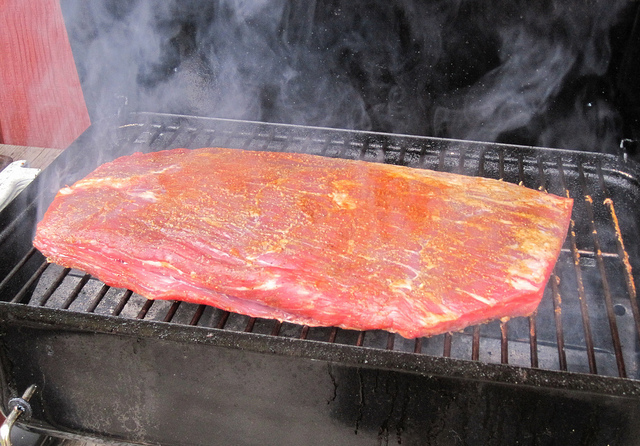
Photo licensed via Creative Commons by Flickr member pinprick
Flank
What it is:
A relatively long and flat cut of steak from the low abdominal muscles of the cow. It is characterized by its grain, which features long, string-like fibers running through the steak. Though extremely flavorful, the flank steak can be a tough cut of meat.
How to cook it:
Slow cooking techniques using moisture, such as braising, are great to help soften this tough cut of meat. It can also be grilled, but be prepared to watch it. Marinate the steak first and monitor it very carefully, as this is an easy cut to overcook when it’s on high heat, and it can also be tricky to remove from the grill.
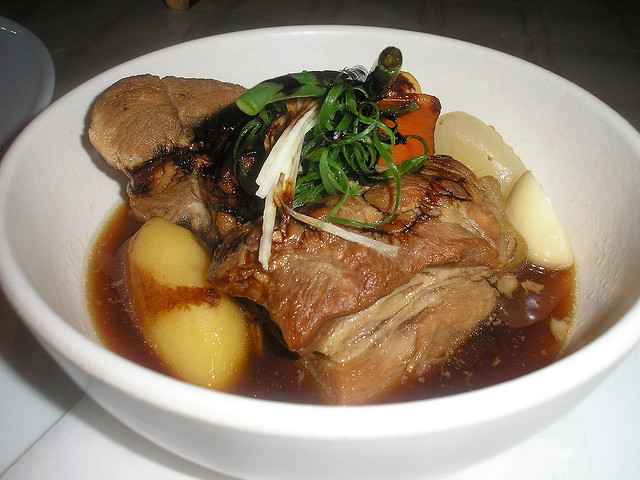
Photo licensed via Creative Commons by Flickr member Nikchick
Plate
What it is:
Also known as “short plate,” this is from the front belly of the cow, just below the rib cut. The short plate produces types of steak such as the skirt steak and hanger steak, as well as short ribs. It’s characterized by its high fat content and the large amount of cartilage that’s in this cut.
How to cook it:
The challenge with the plate cut of beef is to maximize all of the flavor from the high fat content but minimize the tough texture. Braising is a fantastic choice for beef plate, softening everything and allowing the fat to flavor the entire dish. When served in a light broth or sauce espagnole, it’s a thing of great beauty. Marinating and pan frying the meat is also quite popular, and skirt steak is often used in dishes such as carne asada. Meat from the beef plate is also used in ground beef.
Rib
What it is:
From the center section of the rib, this cut’s tender texture and well-distributed marbling makes it one of the more desirable (and expensive) cuts of beef. The rib cut is where you’ll get the rib roast and rib-eye steak.
How to cook it:
Because it’s so tender, beef rib is well suited for various forms of dry-heat cooking, and does not require marinating. In French cooking, it’s called entrecôte, which translates as “between the ribs,” and it’s often served with a compound butter or delicious brown sauce.

Photo licensed via Creative Commons by Flickr member Su-lin
Shank
What it is:
The shank comes from the upper leg portion of the cow. Since this is a very well exercised part of the body, the meat is lower in fat and tends to be sinewy and dry.
How to cook it:
To be completely honest, this is more often used as an ingredient or component than as a stand-alone beef dish. It is often used for beef stocks and to make low-fat ground beef. If cooking, as with most tougher cuts of meat, slow cooking methods involving moist heat work best with shank beef. Yep, that means it’s a great meat for braising. It’s sometimes used in the classic and cozy slow-cooked French dish beef bourguignon. As it is very lean, it’s also used to prepare very low-fat ground beef.
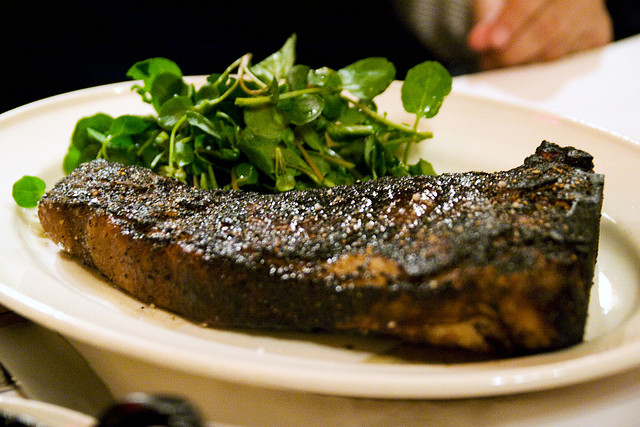
Photo licensed via Creative Commons by Flickr member roboppy
Short loin
What it is:
This cut comes from the back of a cow, below the ribs but before the rump, including part of the spine and the top loin and tenderloin. Cuts of steak that come from this region of the cow include porterhouse, strip steak and T-bone. Steaks from the short loin are desirable with their extremely tender texture and superior flavor.
How to cook it:
To let the flavor shine, you want to do as little as possible with steaks from the short loin. While simple dry heat methods, such as grilling or pan frying, are best, this doesn’t mean that you can’t be creative with your cookery. Crusting the steak with pepper or spices, or serving with compound butter or a delicious sauce can make this a simple but stellar meal.
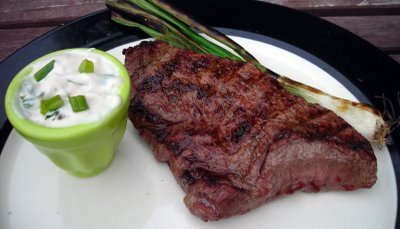
Photo via Coconut & Lime
Sirloin
What it is:
This is the rear, back portion of the cow, continuing behind the section from which short loin cuts. The sirloin is divided into a few different cuts, the most prized of which is the well marbled top sirloin, which is often marketed under that name. The bottom sirloin is larger but less tender, and generally cheaper. In general, sirloin cuts are good in flavor and less expensive than short loin cuts.
How to cook it:
Sirloin steaks can be cooked in a variety of ways. Because they are not too tough, they don’t need to be marinated before cooking. They can be pan-fried on the stove, grilled, broiled and roasted. It’s a great steak to serve with a potato or homemade pasta on the side.
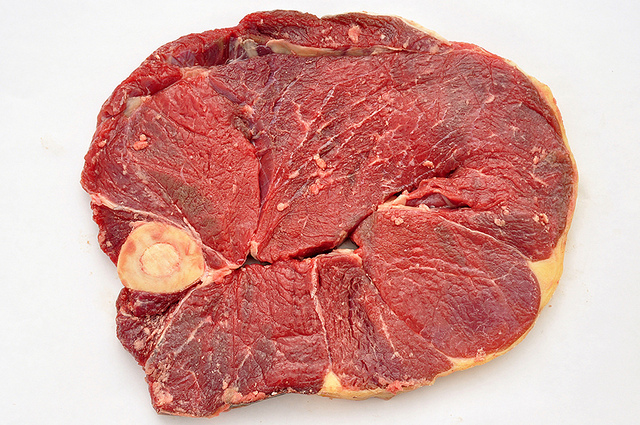
Photo licensed via Creative Commons by Flickr member Carnivore Locavore
Round
What it is:
A round steak comes from the section of the cow directly below the rump but above the shank. It is round in shape because of the part of the leg from which it is cut, and may or may not come with the bone still connected. “Eye” round, bottom round and top round are the different types. This is a lean cut and it is moderately tough.
How to cook it:
Because of its lack of fat and marbling, dry heat methods of cooking, such as grilling or roasting, can dry out round steak. Moist heat methods, such as braising, will tenderize the texture while preserving the flavor. Round steak (along with shank) is also often used to make beef jerky.

Share tips, start a discussion or ask one of our experts or other students a question.
No Responses to “Savory Saturday: What Are the Different Cuts of Beef?”